1940 was a difficult time for many Americans. Although the economy was improving the country was still in the grips of the Great Depression. The relatively new comic book industry provided work for some artists but it did not provide the big time money like a successful syndication strip. For a comic book artist to make a good living he had to be talented and hard working. Well the newly formed team of Simon and Kirby were certainly both hard working and talented. Newly arrived to form the core of Timely’s first bullpen, the duo were hard at work on the Fiery Mask, the Vision and the short lived Red Raven. But that was not enough for Joe and Jack, as they also moonlighted for other publishers. Kirby, probably by himself, would do the Solar Legion for Crash Comics. Jack would also join Joe on Simon’s earlier creation, the Blue Bolt. The two would also work on some existing features for Prize Comics one of which was Ted O’Neil.
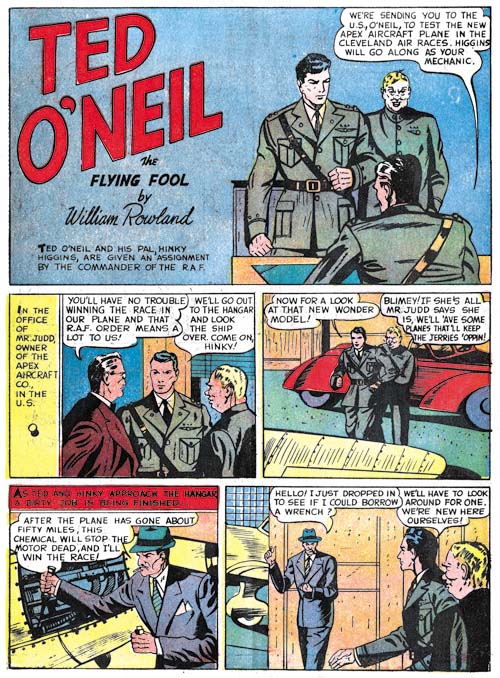
Prize Comics #7 (December 1940) “Ted O’Neil”, art by William Rowland
Prize Comics was a fairly new title with the first issue having a March 1940 cover date. Ted O’Neil was a feature of Prize Comics right from the start. Unfortunately I have seen none of the earlier issues so I have little idea how the feature started out. By Prize Comics #7 (December 1940) Ted O’Neil was an American in England’s Royal Air Force. The splash page credits William Rowland with for the story. Early in the golden age of comics such credits often refer to the writer and not the artist. However Who’s Who of American Comic Books shows Will Rowland as the artist for other titles so I think we can safely say he is the artist for this Ted O’Neil story as well. Rowland may also have written the story as well as was so commonly the case this early in the history of comic books.
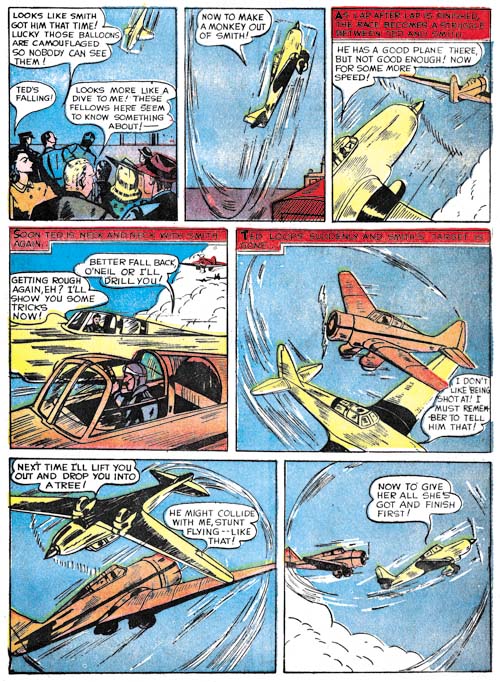
Prize Comics #7 (December 1940) “Ted O’Neil” page 4, art by William Rowland
What can I say, while I would not call Rowland a bad artists, I just cannot get to exciting about him either. Rowland tries hard to make the story interesting but he just is not quite up to it. The story itself is a bit clunky and the artwork a bit stiff. While the flying scenes are easy to understand they just do not grab the reader. I really do not mean to be too hard on William Rowland’s work on this Ted O’Neil story because it compares well with most comic book stories from that period.
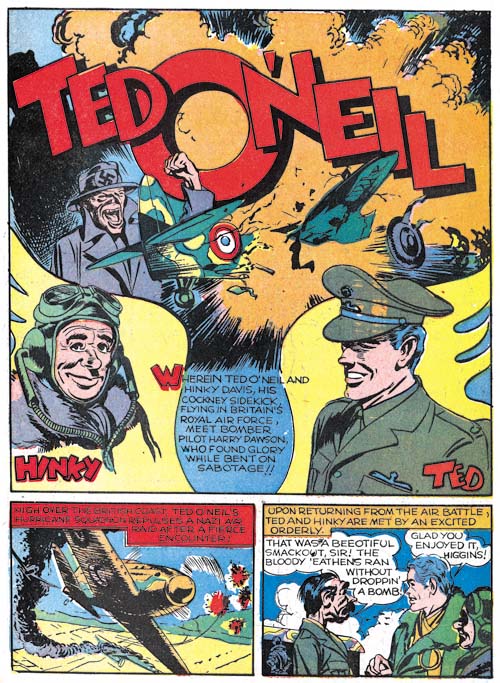
Prize Comics #8 (January 1941) “Ted O’Neil”, pencils by Jack Kirby
Simon and Kirby’s work for Prize are all unsigned. Some fans like to give Kirby all the credit for this work, but just because we cannot see clear indications of Simon’s participation does not mean that this was not a collaborative effort. I prefer to provide joint credits for their work once Simon and Kirby had teamed up unless there is good reason to do otherwise. (The only exception that comes to mind is the Fiery Mask story from Human Torch #2 which is so close to Joe’s earlier efforts that I wonder if it had been left in inventory for a time).
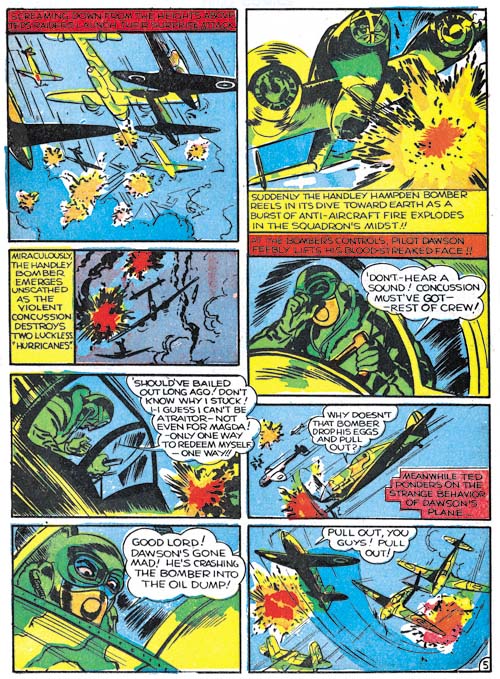
Prize Comics #8 (January 1941) “Ted O’Neil” page 5, pencils by Jack Kirby
It should come as no surprise that Kirby’s pencils for the Ted O’Neil story found in PC #8 was much superior to Rowland’s from PC #7. Simon and Kirby were not yet famous but you have to wonder if some of the more observant artists had not begun to take notice of Jack’s art. Perhaps not since Simon and Kirby traits have not taken full effect. Here and there part of a figure will extend beyond the panel boundaries but it is all very tentative and easily overlooked. There is a circular panel but it is a small insert and not the larger ones that Joe and Jack would use later to such great effect. A couple of panels have a sinuous edge but none of the panels have the irregular borders that played such an important part of Simon and Kirby art for a time.
But observant readers might have noticed something special. Rowland’s flying scenes are all viewed from a distance while Jack would pan in and out. It does not sound like much but it reminds the reader of the very human occupant of the cockpit and keeps the eye interested. Rowland does not provide a single close-up in his story while Kirby provides many.
Not just the art is interesting but the story is as well. If Joe and Jack were presented a script they already had developed the habit of rewriting it. Rowland’s story was a straight forward action tale but Joe and Jack would add a little humor. One scene were Blinky receives a kick in his rear end for good luck reminds me very much of a scene from a much later Kirby story, “Street Code” where a kid’s hunchback is rubbed for similar reasons.

Prize Comics #9 (February 1941) “Ted O’Neil”, pencils by Jack Kirby
While America had not entered the war, Britain was in the thick of it with their Royal Air Force battling Germany for command of the skies. However Edward R. Murrow’s live broadcasts from London during the Blitz incited many Americans to support England. This certainly was the reason that Ted O’Neil ended up in the R.A.F. But Rowland hardly made use of that connection. While the Germans are mention in PC #7, the bad guy works for another plane manufacturing company. Simon and Kirby places Ted O’Neil in the thick of it. We see the Battle for Britain and the London Blitz. There are saboteurs and spies. Ted O’Neil may not have worn a colorful costume and his only power came from flying a plane, but Simon and Kirby were already laying the ground works for their soon to be released Captain America.
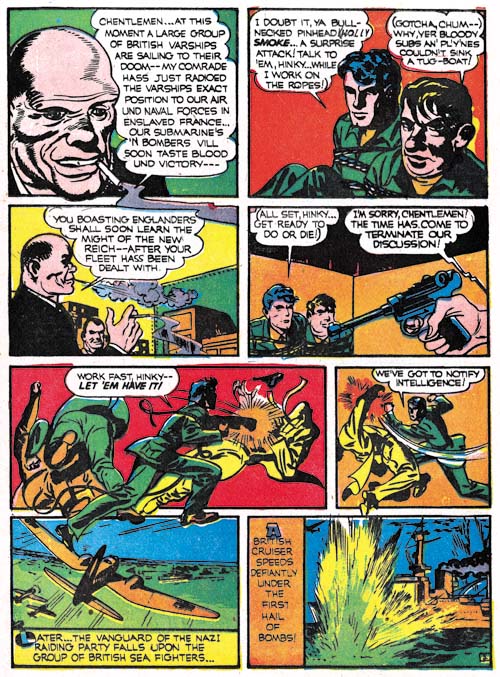
Prize Comics #9 (February 1941) “Ted O’Neil” page 3, pencils by Jack Kirby
By PC #9 even the art work was becoming more powerful. Note how the figures have begun to escape the boundaries of the panels in a more obvious fashion. Joe and Jack had flexed their artistic muscles and they were ready to explode in full force with Captain America. Even before it hit the stands they must have known they had something special in Captain America. Issue #9 would be their last work for Prize for many years. Joe and Jack would do a rush job to produce a special edition of Captain Marvel that would get released in the same month as the first Cap comic. That would be the end of their moonlighting for a while except for some covers that Joe would do for free as a favor to his friend Al Harvey. Previously Simon and Kirby almost went unnoticed but with Captain America a big success everyone in the industry took paid attention and comic books were never the same.

